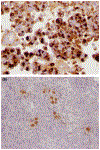Children with MEN1 gene mutations may present first (and at a young age) with Cushing disease
- PMID: 29927501
- PMCID: PMC6341462
- DOI: 10.1111/cen.13796
Children with MEN1 gene mutations may present first (and at a young age) with Cushing disease
Abstract
Objective: Cushing disease (CD) is a rare entity caused by ACTH-secreting pituitary tumours, leading to prolonged hypercortisolism. Most cases are sporadic but can rarely occur in the context of familial predisposition, due to germline mutations in genes such as MEN1, leading to multiple endocrine neoplasia type 1, MEN1. We have reported previously that CD can be the first and only presenting manifestation of MEN1. In this report, we describe a cohort of paediatric patients who presented with CD as the first manifestation of MEN1.
Materials and methods: A retrospective analysis of paediatric patients admitted to the National Institutes of Health (NIH) Clinical Center for evaluation of hypercortisolism, between 1997 and 2017. MEN1 was diagnosed on a clinical, familial and/or genetic basis.
Results: Of a total of 238 children with CD, six patients were subsequently diagnosed with MEN1, three males and three females with a mean age at diagnosis of CD at 13.4 ± 2.9 years. Five of the six patients had familial MEN1 and one patient was a sporadic case. Additional manifestations of MEN1 included primary hyperparathyroidism in three patients and hyperprolactinemia in two patients.
Discussion: This report describes a paediatric patient population with MEN1 in whom CD was the initial manifestation, confirming a previous observation that paediatric patients with MEN1 may present first with an ACTH-producing adenoma. Therefore, germline MEN1 mutations should be sought in paediatric CD and tested for when there is a suggestive family history and/or other manifestations.
Keywords: Cushing disease; MEN1; MEN1 mutations; paediatric patients.
Published 2018. This article is a U.S. Government work and is in the public domain in the USA.
Conflict of interest statement
CONFLICT OF INTEREST
The authors report no conflict of interests in this work.
Figures
References
-
- Holst JM, Horváth-Puhó E, Jensen RB, et al. Cushing’s syndrome in children and adolescents: a Danish nationwide population-based cohort study. Eur J Endocrinol. 2017;176(5):567–574. - PubMed
-
- Thakker RV, Newey PJ, Walls GV, et al. Clinical practice guidelines for multiple endocrine neoplasia type 1 (MEN1). J Clin Endocrinol Metab. 2012;97(9):2990–3011. - PubMed
-
- Brandi ML. CONSENSUS: guidelines for diagnosis and therapy of MEN type 1 and type 2. J Clin Endocrinol Metab. 2001;86(12):5658–5671. - PubMed
-
- Giusti F, Cianferotti L, Boaretto F, et al. Multiple endocrine neoplasia syndrome type 1: institution, management, and data analysis of a nationwide multicenter patient database. Endocrine. 2017;58:349–359. - PubMed
Publication types
MeSH terms
Substances
Grants and funding
LinkOut - more resources
Full Text Sources
Other Literature Sources
Molecular Biology Databases


